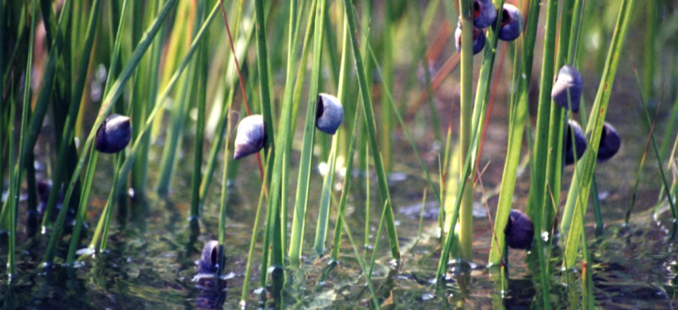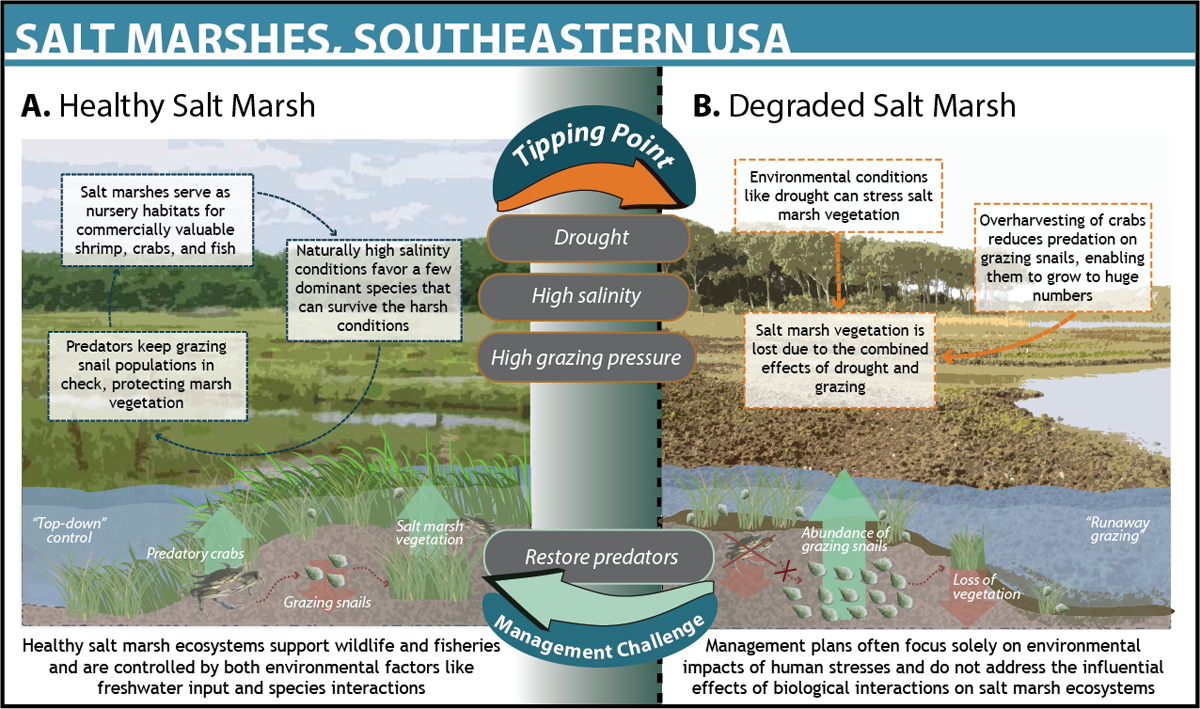Research on the continued decline of Southeastern United States salt marshes has suggested a new focus on species interactions for salt marsh management
Tipping points for salt marshes
Salt marshes border large regions of the southeastern United States coast, growing at the margin of the land and the sea. These important ecosystems provide nursery habitat for numerous marine species, including commercially valuable shrimp, crabs, and fishes, and foraging habitat for wading birds.1 Salt marshes are regularly flooded by high salinity water from the incoming tides, and these ecosystems have few dominant species that are able to withstand these harsh conditions. Even so, salt marshes manage to be among the most productive systems in the world,2 providing valuable services to species and humans including acting as natural protective barriers during extreme weather events, such as hurricanes.
Unfortunately, human activities have resulted in the loss or degradation of 50 percent of salt marshes worldwide.3 Along the coastal southeastern United States, extensive salt marsh die-offs have been occurring for nearly two decades, and scientists largely attributed these die-offs to changes in environmental conditions, such as droughts4 and nutrient loads, that limit the growth of dominant vegetation.5 The idea that many ecosystems are controlled by the availability of resources, such as plants, is called “bottom up” control and places emphasis on the physical and chemical factors of the environment that may limit plant growth, and subsequently the entire ecosystem.6
However, the continued and sometimes drastic decline of salt marshes led some scientists to explore alternative hypotheses about the dynamics of these valuable ecosystems. Through a series of experiments over several years, scientists came to understand that salt marsh systems can also be controlled by the number of grazers that feed on salt marsh vegetation.6 This concept—where ecosystems are controlled by the number of consumers, or predators, is considered “top-down” control, and focuses on the effect that higher level species can have on structuring ecosystems.6
For salt marshes in the southeast, scientists found that blue crabs play a key role in keeping the population of grazing snails low enough for salt marsh vegetation to grow.6 Overharvesting of blue crabs by humans removes the snail’s common predator and enables them to graze unregulated on salt marsh vegetation, forming huge densities that can turn productive grasslands into a barren mudflat within months.6 These results indicate that both environmental stressors coupled with snail grazing pressure contribute to a tipping point for salt marshes, resulting in many of the mass die-off events observed in the southeastern United States.4
How Managers Tackled the Problem
In response to the alarming rates of salt marsh die-offs in Louisiana in 2000, management plans to restore the coast were developed under an executive order of the Governor, including plans to strategically manage watersheds and river input into salt marsh ecosystems.7 Furthermore, since 1990, nearly 500,000 acres of wetlands in Louisiana have been protected by funds from the Coastal Wetland Planning Protection and Restoration Act (CWPPRA). Due to the longstanding belief developed in the 1950s and 60s that salt marshes are controlled solely by “bottom-up” processes, most management actions for salt marshes across the southeast have focused on managing for coastal protection from development and improving water quality through limits on nutrient and sediment runoff.8
While environmental conditions such as nutrient runoff and drought are considered to play an important role in contributing to these massive salt march die-offs, there are currently no management plans or actions that account for or incorporate the effects of predator-prey consumer interactions between crabs, snails, and salt marsh vegetation in structuring salt marsh ecosystems.
What We Can Learn
The continual decline of salt marshes along the southern coast of the United States and elsewhere around the world illustrate that human activity is having a major influence on the sustainability of these highly productive and ecologically valuable ecosystems. While management to reduce the intensity of human impacts on salt marshes has largely focused on the chemical and physical conditions of salt marsh ecosystems, little to no integration of management actions that address “top-down” control processes has occurred.5 This indicates that increased communication between scientists, managing entities, and the general public may be a necessary step to effectively manage salt marsh ecosystems, as these systems are highly vulnerable to “runaway grazing” and consumer-driven collapse than is currently unaccounted for in management.5 For example, more widespread discussion and collaborative efforts about the effects of biological interactions on salt marshes can inform future management plans to include the management of coastal fisheries that affect snail predator densities and ultimately salt marsh sustainability.
As the Ocean Tipping Points team has come to understand, the most successful scenarios for resource management occur when management is threshold-based, populations are monitored routinely, and the geographic scale for management is relatively small.
Learn more about our Management Review research and Ocean Tipping Points project.






